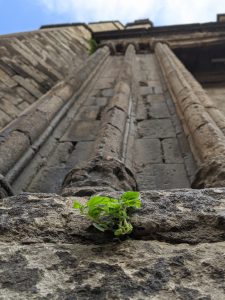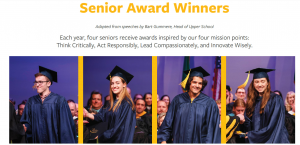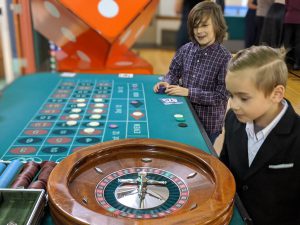(1) designs and implements courses that reflect teacher mastery of their academic discipline and its teaching methodologies
(2) designs and implements courses framed by the school’s pedagogical tenets – inquiry, experience, and integration
(3) collaboratively designs and evolves course curricula that are reflective of their academic discipline’s philosophy and derivative of the school’s overarching philosophy
(4) updates course content to reflect the contemporary world
On the surface, the class outlined below is a biology class, but it’s much more than that. Adam Waltzer built the core of the class by combining traditional biology content and infusing it with modern advances and labs available to us because of our proximity to some very high level bio tech companies. In the last couple years, I have added in a number of aspects aimed at helping meet the needs of freshman that to my knowledge aren’t being addressed elsewhere, or at minimum are worth repeating. Most notable are esential study skills and life balance perspective. Students are asked to experiment with and reflect of components of their learning process that goes much further than just biological content. It’s all connected back to our Major Themes and the scientific process which hopefully helps them to “inspire students to create a better world through Critical Thinking, Responsible Action, Compassionate Leadership, and Wise Innovation.” (Welcome Letter)
(1) designs and implements courses that reflect teacher mastery of their academic discipline and its teaching methodologies
Consult: Textbooks, Colleagues (especially 8th, Chem and Adv Bio), College admissions requirements, SAT/ACT, Counselors, other 9th grade teachers, 9th grade advisory
Overview of what the course covers:
Fall
- Unit 1: Microscopy and Scientific Method
- QA: Making a Living
- Unit 2: Evolution and Natural Selection
- Unit 3: DNA MA: Emergence Project
Winter
- Unit 4: Energy and Metabolism
- Unit 5: Protein Synthesis
- Unit 6: Genetic Engineering
- MA: Independent Lab (students modify a lab from fall and do a full write up
- MA: Topic Proposal (students propose a topic to study in spring)
Spring*
- Unit 7: Immune System – culminating with COVID-19 policy proposal
- Unit 8: Nervous System – special topics on Anxiety, Depression, Addiction, Sleep
- Unit 9: Ecology – climate change and environmental impact
- MA: Teach for a day. Students plan a lesson, activity, reading and homework for a topic specific to one of the units
- MA: Self designed Lab experiment. Students come up with an idea, research and perform an experiment
*Built new each year based on news and proposals from students in winter
OneNote is the textbook for the class. It contains a mix of traditional textbook readings, interactive content, current news articles, lecture slides and student created content. Here’s an overview of the organization of the OneNote notebook
- Section 1: Class Tasks – daily agenda, readings, images and lecture slides for the day
- Section 2: Readings – Functionally this is the textbook. News Articles, Textbook Sections and reference material that students need to know for the test.
- Section 3: Lab Notebook – I keep a list here of all the labs and modeling activities we do in class with the minimum requirements of what must be documented by students in their own lab notebook.
- Section 4: Current Events – News articles and other resources found by me or students that are relevant to content we have studied in class. This material is not on the test, but often becomes the subject of class discussions with deepen students understanding of the Major Themes
- Section 5: References – Rubrics, syllabus, general resources etc
Here is an example of one of the major assignments for the fall MA-Emergence Project
The submissions from this year 2019-20 Emergence Projects
It’s a lot to take in, but hopefully that gives you the panoramic overview

(2) designs and implements courses framed by the school’s pedagogical tenets – inquiry, experience, and integration

In order for students to grow as students and humans, they must be faced with challenges and obstacles or they will simply become complacent. However, if those challenges are too difficult they risk developing a sense of hopelessness and stop trying. The key is to find ways to build the course so there is a path of appropriate challenge for each student. Then gain the trust and respect of the students so they value your opinion or at least pretend to in order to get the grade they want. Then, get to know the students well enough to steer them to the right path. More challenge for those coasting and less for those struggling to find balance. With practice, they start to navigate the maze on their own.
Inquiry examples – Students design their own labs and keep lab journals Microscope example student 1 Microscope example student 2
Experience – Both traditional textbooks and scientific articles are read. Students participate in discussions in class, perform lab activities, and identify some of the modern challenges and applications of biological content
Integration – Students are asked to first learn the basics of the biology, but then apply that knowledge as they develop their own perspectives on the ethical applications of the technology as well as the beneficial ways that an understanding of biology can improve ones quality of life. Here’s the topic itinerary for one of the 5 classes during the spring of 2019. Student teaching agenda – Spring
- (3) collaboratively designs and evolves course curricula that are reflective of their academic discipline’s philosophy and derivative of the school’s overarching philosophy
The school mission is a critical part of everything we do at EPS. Dr. Macaluso references it in her welcome letter on the first page of the website identifying who we are. It’s also the basis of our senior award every year. I think it’s the best tool to show a little insight into how this plays out in the classroom.
- Think Critically – Bloom’s Taxonomy is explicitely taught to the class. Once students are familiar with the ideas they get much better at identifying what type and level of thinking is being requested.
- Act Responsibly -Behavior expectation. Students do self-reflections and set personal goals. There are basic expectations (don’t prevent anyone else from learning) that are standard, but advanced growth is personal based on their goals/strengths/reflections. Here’s an example of a self assessed engagement assignment
- Innovate Wisely – Students design their own labs. In order to do so successfully they must balance equipment skills, need to for useful data and make it fit within their available time constraints. Here are the independent lab class slides used to introduce this idea in class.
- Lead Compassionately – this is perhaps best illustrated in the spring when students are asked to teach for a day. The previous document gives clear list of criteria, but still leaves a lot of freedom for students to develop their own lesson. Here is the topic agenda. for a class in the spring of 2019, as you can see, there are a variety of topics that come out of these classes. Some students develop them entirely on their own and others might meet with me 3 or 4 times to help generate ideas and shape their activities.
(4) updates course content to reflect the contemporary world

Sometimes you have to pick a square and hope for the best. Collecting feedback from students, parents and the educational community at large greatly increases the odds that you’ll be able to choose wisely. Here are a few of the ways that I hedge my bets when updating the content.
- Current Events – students share current events in biology. This gets them comfortable talking in class and helps me learn where their interests lie.
- Ethics unit where we address BioEthics and balance between what we CAN do vs what SHOULD we do. This helps students to see one of many potential careers related to biology that they may not think of.
- One of the major themes – for class is Science and Society. Through the processes of science, humans learn about the natural world.
Technology applies this knowledge in new ways to solve human problems and further scientific knowledge. Science uses inquiry, controlled experiments and peer review. Models, (physical, mathematical, conceptual, etc.) help scientists study and understand complex systems. Science and technology inevitably lead to ethical questions that must be considered by all citizens.